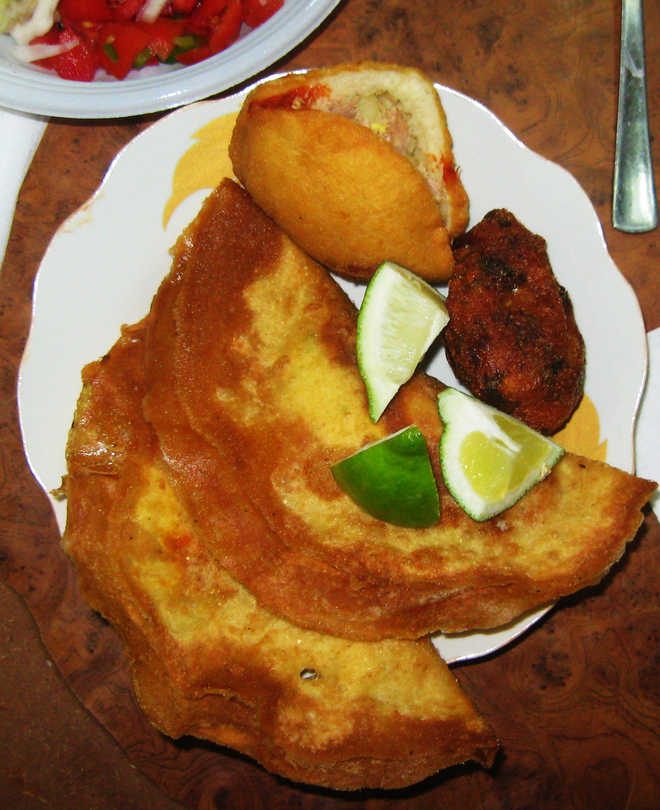
Tunisian brik
Krishnaraj Iyengar
Fast food has a new avatar in the 21st century. Be it the crowded bazaars of Mumbai, the glitzy international eateries of San Francisco or Melbourne’s Middle Eastern quarter, it’s the hummus-falafel fad that rules.
Originating in the Levant region, namely Syria, Lebanon and Egypt, and extending to Turkey and Greece, Levantine cuisine is delightful, refreshing, delicious and easy to cook. However, little is known about the cuisine of the Maghreb region or the western Arab world, namely Tunisia, Algeria, Libya and Morocco known as Al Maghreb al Arabi. The occasional Moroccan couscous indeed springs up, but Maghrebi cuisine is still an unexplored territory in India.
Dining with my friend Sidi Adel, a Tunisian culture scholar, banker and traditional chef, at his quaint cottage on Tunisia’s Djerba Island unveiled the world of Maghrebi cuisine to me. The highlight was brik, a magnificent mixture of mashed potatoes with parsley, capers, a soft boiled egg and choice of tuna, a pinch of salt and pepper, all wrapped in a dough sheet, deep fried and served hot. Harissa, the Tunisian fiery red chilli pepper paste is optional, quite like the Indian chutney.
His keftejine sandwich (a hefty baguette sandwich with generous stuffing of salads, onions, cheese, parsley, coriander, cumin, aubergine) and kafteji platter — a mélange of assorted fried vegetables, tomatoes, peppers, eggs, zucchinis and pumpkins, topped with tomato sauce, chopped onions and parsley — left no room for lunch!
In Morocco, tajine refers to slow-cooked stew prepared with sliced meat, poultry or fish, served in conical earthen containers with circular bases. The Tunisian version, on the other hand, is a quiche resembling an Italian frittata. A wholesome meal in itself, the tajine is an intricate play of flavours — meat, onions, spices, rosebuds, ground cinnamon, ground coriander, beans, chickpeas, potatoes, eggs, dried mint, parsley and often, sundried tomatoes and cooked vegetables. Tajines are mouth-melting preludes to culinary seduction, Tunisian style.
The legendary couscous, appearing quite like a Rubik’s Cube of colourful ingredients, consists of steamed semolina and wheat flour, boiled potatoes, onions, carrots and turnips often cooked in a mild or spicy broth and served with meats. Diverse in its flavours, savouring a couscous is a fascinating experience with each ingredient offering an individual set of flavours, yet blending into the whole. Semolina provides it a fine texture. Each chef in Maghreb prepares his own innovative couscous version, or so is it believed.
Salads like slata tounsia, a combination of hard-boiled eggs, green and black olives, cheese, tomatoes and coriander, refresh you before a hearty meal. In Morocco, desserts are mouth-melting and seductive, like halwa chebakia, a fried sesame cookie coated with honey, or briouat, a sweet and savory puffed pastry. While Algeria boasts of griwech, a thin dough pastry, Tunisia’s samsa, a honey, almond and sesame filo, the delicious bouza bil haleeb (milk ice cream) and the truly irresistible assidat zgougou pudding with nuts call for an instant aha!
No mention of Maghrebi cuisine is complete without a homage to its legendary shay bil na’na or mint tea. Served in hour glass-shaped cups, anytime is tea time in Maghreb. “Moroccan mint tea is sweeter and has more mint. In Tunisia, it is less sweet and headier. I prefer mint tea with honey. It is far more delicious” says Adel.
In Libya, the rugged shaay ahmar or red tea with mint is the signature drink, nothing but lightly brewed black tea that turns red. Tunisia, Morocco and Algeria are former French colonies and the famous French-Maghrebi saying sums up the mint tea saga thus: “Le premier verre est aussi doux que la vie, le deuxième est aussi fort que l’amour, le troisième est aussi amer que la mort.” The first serving is as gentle as life, the second, as strong as love, the third, as bitter as death!



























